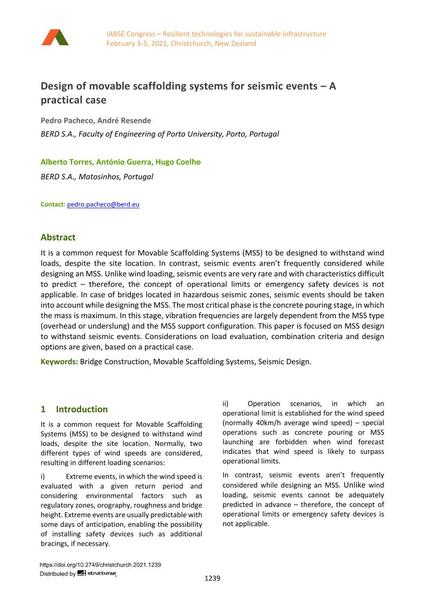Design of movable scaffolding systems for seismic events – A practical case

|
|
|||||||||||
Bibliographic Details
| Author(s): |
Pedro Pacheco
(BERD S.A., Faculty of Engineering of Porto University, Porto, Portugal)
André Resende (BERD S.A., Faculty of Engineering of Porto University, Porto, Portugal) Alberto Torres (BERD S.A., Matosinhos, Portugal) António Guerra (BERD S.A., Matosinhos, Portugal) Hugo Coelho (BERD S.A., Matosinhos, Portugal) |
||||
|---|---|---|---|---|---|
| Medium: | conference paper | ||||
| Language(s): | English | ||||
| Conference: | IABSE Congress: Resilient technologies for sustainable infrastructure, Christchurch, New Zealand, 3-5 February 2021 | ||||
| Published in: | IABSE Congress Christchurch 2020 | ||||
|
|||||
| Page(s): | 1239-1246 | ||||
| Total no. of pages: | 8 | ||||
| DOI: | 10.2749/christchurch.2021.1239 | ||||
| Abstract: |
It is a common request for Movable Scaffolding Systems (MSS) to be designed to withstand wind loads, despite the site location. In contrast, seismic events aren’t frequently considered while designing an MSS. Unlike wind loading, seismic events are very rare and with characteristics difficult to predict – therefore, the concept of operational limits or emergency safety devices is not applicable. In case of bridges located in hazardous seismic zones, seismic events should be taken into account while designing the MSS. The most critical phase is the concrete pouring stage, in which the mass is maximum. In this stage, vibration frequencies are largely dependent from the MSS type (overhead or underslung) and the MSS support configuration. This paper is focused on MSS design to withstand seismic events. Considerations on load evaluation, combination criteria and design options are given, based on a practical case. |
||||
| Keywords: |
seismic design bridge construction Movable Scaffolding Systems
|
||||

